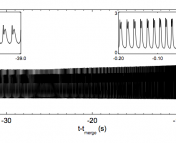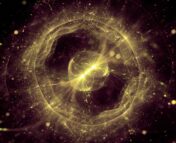Title: A Kilonova Following a Long-Duration Gamma-Ray Burst at 350 Mpc
Authors: J. C. Rastinejad, B. P. Gompertz, A. J. Levan, W. Fong, M. Nicholl, G. P. Lamb, D. B. Malesani, A. E. Nugent, S. R. Oates, N. R. Tanvir, A. de Ugarte Postigo, C. D. Kilpatrick, C. J. Moore, B. D. Metzger, M. E. Ravasio, A. Rossi, G. Schroeder, J. Jencson, D. J. Sand, N. Smith, J. F. Agüí Fernández, E. Berger, P. K. Blanchard, R. Chornock, B. E. Cobb, M. De Pasquale, J. P. U. Fynbo, L. Izzo, D. A. Kann, T. Laskar, E. Marini, K. Paterson, A. Rouco Escorial, H. M. Sears, C. C. Thöne
First Author’s Institution: (CIERA/Northwestern)
Status: Nature [Submitted — Closed Access]
Since their detection back in 1967, gamma-ray bursts have been a fundamental tool for astronomers to learn about the universe. With over 7000 gamma-ray bursts detected to date, these extremely energetic, extragalactic sources of gamma–ray emission have provided rich datasets for learning about the death of stars, mergers of compact objects like neutron stars (NS) and black holes (BH), along with how the heaviest elements in the universe were created.
Gamma-ray bursts are typically split into two different categories: short and long gamma-ray bursts. Traditionally, short gamma-ray bursts (those which last less than 2 seconds) are produced by compact object mergers while long gamma-ray bursts (those lasting more than 2 seconds) are produced during the death of rapidly rotating, massive stars. However, the distinction between the two is a bit more blurry than this, with some short gamma-ray bursts sharing some of the features of long gamma-ray bursts.
Here’s where today’s authors come in! They find the first evidence for a long gamma-ray burst associated with a compact object merger. Wait, what?! Aren’t short gamma-ray bursts associated with compact object mergers? That’s what we thought… but today’s paper really flips this idea upside down!
We’ve got a detection, folks!
The long gamma-ray burst (shown below in Fig. 1) was originally detected by Swift/BAT and Fermi/GBM on December 11, 2021. The long gamma-ray burst lasted for a whooping 51.37 seconds, with a spectral hardness (the energy as a function of frequency) similar to that of other long gamma-ray bursts. The burst consists of lots of smaller, overlapping pulses followed by softer (less energetic) emission.
The authors were able to localize the long gamma-ray burst to a galaxy ~350 Mpc away. This might seem really far (our galaxy is only ~20 kpc wide), but this is actually one of the closest long/short gamma-ray bursts detected yet!
Multi-wavelength follow-up
The authors followed up the source using a variety of multi-wavelength telescopes such as the Nordic Optical Telescope, the Calar Alto Observatory, the Hubble Space Telescope, the Large Binocular Telescope, the Gran Telescopio Canaries, the Very Large Array, and the MMT. They looked for an associated supernova, which is what you would expect for a “classic” long gamma-ray bursts, but didn’t find anything! They were able to rule out a supernova that was ~200x more faint than the typical supernova expected for this type of event. They did, however, find an uncatalogued source at the same location that was fading rapidly over the three days after the gamma-ray burst.
The authors next fit a model to their X-ray and radio light curves, along with the optical-near infrared photometry obtained as a part of their multi-wavelength follow-up. They find that a simple afterglow model does not fully fit the data. Instead, a three-component kilonova model is needed to properly model it! And the kilonovae is the key to couple the GRB to a compact object merger.
Quick dive into kilonovae
Kilonovae are produced when two compact objects merge. They are similar to supernovae, albeit only ~1/10 to 1/100 as powerful (hence their name). They are powered by radioactive decay of elements produced during the merger, and peak ~a few days post merger. They are particularly special in that they are predicted to create many (if not all) of our heavy elements through r-process nucleosynthesis. The concept of a kilonova was confirmed in 2017 when the short gamma-ray burst GRB 17081 was not only detected 1.7 s after the gravitational wave event GW170817, but also was detected in conjunction with a kilonova. Kilonovae are, however, hard to detect, as they fade rapidly, have low luminosities, and have high opacities.
Okay, back to the paper
As shown below in Fig. 2, the multiwavelength data is not well fit by solely an afterglow model (compare the dashed lines with the data points). Instead, an afterglow plus kilonova (the solid lines) provide by far the best fit to the data! The kilonova is also likely responsible for the uncatalogued source they say fading rapidly over the three days post-gamma-ray burst. However, the kilonovae isn’t the only evidence for this long gamma-ray burst’s association with a compact object merger. Some other evidence includes the fact that:
- the host galaxy is more similar to the host galaxy of compact object mergers than to that of long gamma-ray bursts
- there is no sign of an underlying stellar component at the location of the long gamma-ray burst
- there is a spectral lag between harder and softer energy bands which is reminiscent of short gamma-ray bursts
- there is an exponential decline in the X-ray emission that is also more frequently seen with short gamma-ray bursts
So how do we get extended emission from a compact object merger?
It is possible that a NS-NS merger produced a magnetar which powered this emission, or that a NS-BH merger could produce extended emission due to material from the NS falling back on the remnant for several seconds post merger. However, neither of these scenarios perfectly fit the data.
While the authors don’t come to any definitive conclusions on what is causing the long gamma-ray burst to be produced by a compact object merger, their results still have huge implications for the field of gamma-ray bursts! If some long gamma-ray bursts are due to compact object mergers, then our estimations of compact object merger rates determined using solely short gamma-ray bursts could be severely underestimated. There might be a whole bunch of mergers just waiting to be detected! And hopefully with the upcoming LIGO runs we might just be able to find more of these.
Editor: Roel Lefever
Featured image credit: ESO/L. Calçada/M. Kornmesser



